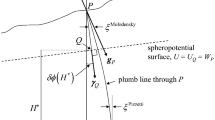Abstract
Vector gravimetry using a precise inertial navigation system continually updated with external position data, for example using GPS, is studied with respect to two problems. The first concerns the attitude accuracy requirement for horizontal gravity component estimation. With covariance analyses in the space and frequency domains it is argued that with relatively stable uncompensated gyro drift, the short-wavelength gravity vector can be estimated without the aid of external attitude updates. The second problem concerns the state-space estimation of the gravity signal where considerable approximations must be assumed in the gravity model in order to take advantage of the ensemble error estimation afforded by the Kalman filter technique. Gauss-Markov models for the gravity field are specially designed to reflect the attenuation of the signal at a specific altitude and the omission of the long-wavelength components from the estimation. With medium accuracy INS/GPS systems, the horizontal components of gravity with wavelengths shorter than 250 km should be estimable to an accuracy of 4–6 mgal (µg); while high accuracy systems should yield an improvement to 1–2 mgal.
Similar content being viewed by others
References
Aviation Week and Space Technology (1992) GPS Attitude Sensing Tested. Nov.30, 1992, p.52.
Britting KR (1971) Inertial Navigation Systems Analysis. Wiley Interscience, Wiley & Sons, New York.
Brown RG (1983) Introduction to Random Signal Analysis and Kalman Filtering. Wiley & Sons, New York.
Brozena JM, Peters MF (1992) The Greenland Aerogeophysics Project: Year 1. In: 48th Annual Meeting Proceedings of the ION.
Colombo OL (1992) Airborne Gravimetry, Altimetry, and GPS Navigation Errors. In: Proc. IAG Symp., From Mars to Greenland: Charting Gravity with Space and Airborne Instruments, General Assembly of the IUGG, Vienna, 1991, Springer Verlag, New York.
Eissfeller B (1989) Analysis of a Geodetical Space-Stabilized Inertial Platform and Integration with GPS. Report no.37, Studies in Metrology, University of the Bundeswehr, Munich, Germany.
Eissfeller B, Spietz P (1989a) Basic Filter Concepts for the Integration of GPS and an Inertial Ring Laser Gyro Strapdown System. Manus Geodaetica 14:166–182.
Eissfeller B, Spietz P (1989b) Shaping Filter Design for the Anomalous Gravity Field by Means of Spectral Factorization. Manus Geodaetica 14:183–192.
Galdos JI (1985) Spectral Analysis of Optimal and Suboptimal Gyro Monitoring Filters. IEEE Trans Aero Elec Sys AES-21(3):372–378.
Gelb A (1974) Applied Optimal Estimation. M.I.T. Press, Massachusetts.
Gleason DM (1992) Extracting Gravity Vectors from the Integration of Global Positioning System and Inertial Navigation System Data. J Geophys Res 97(B6):8853–8864.
Hadfield M, Stiles T, Seidel D, Miller W, Hensley D, Wisotsky S, Foote M, Gregory R (1991) An Improved Ring Laser Gryro Navigator. Technical Paper No.1478-17, SPIE OE/Aerospace Sensing '91 Symposium.
Honeywell (1991) H-423 System Description. Honeywell Military Avionics Division, St. Petersburg, Florida.
Huddle JR (1978) Theory and Performance for Position and Gravity Survey with an Inertial System. J Guidance and Control 1(3):183–188.
Huddle JR (1986) Historical Perspective on Estimation Techniques for Position and Gravity Survey with Inertial Systems. J Guidance and Control 9(3):257–267.
Jekeli C (1984) Analysis of Airborne Gravity Gradiometer Survey Accuracy. Manus Geodaetica 9:323–379.
Jekeli C (1991) The Statistics of the Earth's Gravity Field, Revisited. Manus. Geodaetica 16(5):313–325.
Jekeli C (1992) Balloon Gravimetry Using GPS and INS. IEEE Aerospace and Electronics Systems Magazine 7(6):9–15.
Jordan SK (1981) State-Space Models of Gravity Disturbance Gradients. IEEE Trans Aero Elec Sys AES-17(5):610–618.
Kleusberg A, Peyton D, Wells D (1990) Airborne Gravimetry and the Global Positioning System. In: Proc of IEEE PLANS 1990, Las Vegas, pp.273–278.
Knickmeyer ET (1990) Vector Gravimetry by a Combination of Inertial and GPS Satellite Measurements. Report No.20035, Department of Surveying Engineering, University of Calgary.
Moritz H (1976) Covariance Functions in Least-Squares Collocation. Report no.240, Department of Geodetic Science, The Ohio State University.
Moritz H (1980) Advanced Physical Geodesy. Abacus press, Tunbridge Wells, Kent.
Northrop Corporation, Electronics Division (1986) Gravity Compensation for INS Demonstration Program, Volume 4 — Operational Testing. Report No. AFWAL TR-85-1156, AF Wright Aeronautical Laboratories, Wright-Patterson AFB, Ohio.
Rose RC, Nash RA (1972) Direct Recovery of Deflections of the Vertical Using an Inertial Navigator. IEEE Trans Geoscience Electronics GE-10(2):85–92.
Rapp RH, Pavlis NK (1990) The Development and Analysis of Geopotential Coefficient Models to Spherical Harmonic Degree 360. J Geophys Res B95:21885–21911.
Schmidt GT (1978) Strapdown Inertial Systems — Theory and Applications — Introduction and Overview. In: Strap-Down Inertial Systems, AGARD Lecture Series 95, NATO, 7 rue Ancelle, 92200 Neuilly-sur-Seine, France.
Schwarz KP, Colombo O, Hein G, Knickmeyer ET (1992) Requirements for Airborne Vector Gravimetry, in Proc. IAG Symp., From Mars to Greenland: Charting Gravity with Space and Airborne Instruments, General Assembly of the IUGG, Vienna, 1991, Springer Verlag, New York, pp.273–283.
Soltz JA (1985) Gravity Disturbance Models in the APT System. In: Proc 3rd Internat Symp Inertial Technology for Surveying and Geodesy, Banff, Canada, pp.137–160.
Wei M, Cannon ME, Schwarz KP (1992) Maintaining High Accuracy GPS Positioning ‘On The Fly’. IN: Proc IEEE '92 Position, Location, and Navigation Symposium, pp.403–411.
Author information
Authors and Affiliations
Rights and permissions
About this article
Cite this article
Jekeli, C. Airborne vector gravimetry using precise, position-aided inertial measurement units. Bulletin Géodésique 69, 1–11 (1994). https://doi.org/10.1007/BF00807986
Received:
Accepted:
Issue Date:
DOI: https://doi.org/10.1007/BF00807986




